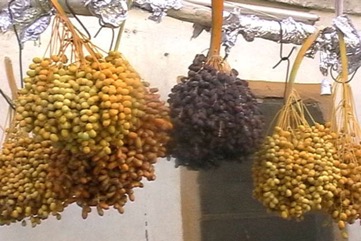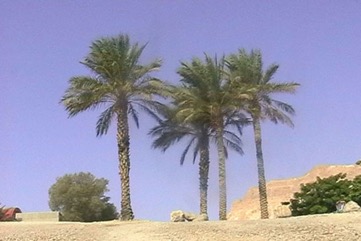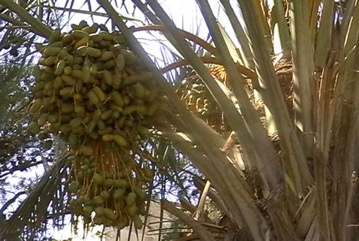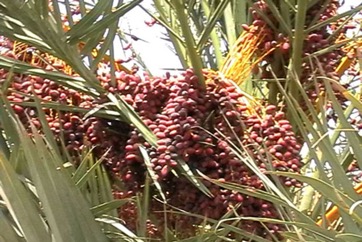Date palm

They suit dry subtropical climates. It needs hot, dry arid climates while fruit mature. It can tolerate salty or brackish water. It can also grow in alkaline soils but with reduced yields. In cold temperate regions the palm grows but rarely flowers. It does best in areas with long dry summers and sufficient heat for fruit to ripen. It should not have rain during flowering and fruit set. For best production it needs 3,400 heat units above 10°C for fruit to fully mature. It can grow in arid places. It suits plant hardiness zones 9-12. In Yunnan.
Also known as:
Akarap, Arabi khejur, Belah, Dabino, Dadel, Datil, Datilera, Dattelpalme, Dattero, Dattier, Dibinodje, Hai zao, Imae, Ita, Ittappazham, Karchuram, Khajur, Kharjura, Kharjuramu, Khorjjuri, Mtende, Nakhla, Nakl-el-balah, Natsume yashi, Palma datilera, Perichchankay, Sunbalun, Sunpalun, Tamar, Tamareira, Tamr, Tenitta, Timir, Ye zao
Edible Portion
- Fruit, Cabbage, Sap, Palm heart, Flowers, Nuts-oil
Where does Date palm grow?
Found in: Africa, Algeria, Angola, Antigua and Barbuda, Arabia, Argentina, Asia, Australia, Bahrain, Bangladesh, Brazil, Burkina Faso, Cambodia, Cameroon, Central Africa, Chad, China, Cuba, Cyprus, East Africa, East Timor, Egypt, Egypt - Sinai, Eritrea, Ethiopia, Fiji, Gambia, Greece, Guam, Guatemala, Haiti, Hawaii, Himalayas, India, Indochina, Iran, Iraq, Israel, Jordan, Kenya, Lebanon, Libya, Madagascar, Malawi, Malaysia, Mali, Marquesas, Marshall Islands, Mauritania, Mediterranean, Mexico, Morocco, Myanmar, Namibia, Nepal, Niger, Nigeria, North Africa, North America, Oman, Pacific, Pakistan, Palestine, Papua New Guinea, PNG, Pakistan, Philippines, Qatar, Rotuma, Sahel, Sao Tome and Principe, Saudi Arabia, SE Asia, Senegal, Seychelles, Sinai, Somalia, South Africa, Southern Africa, South America, South Sudan, Spain, Sudan, Syria, Taiwan, Tanzania, Thailand, Timor-Leste, Tunisia, Turkey, United Arab Emirates, UAE, United States, Vietnam, West Africa, Yemen
Notes: There are 17 Phoenix species.
Status: A major food. It is cultivated.
Growing Date palm
Cultivation: Plants are grown from seed. Seed take 4-5 months to germinate. They begin bearing 5-6 years after planting and reach full production by 15 years. A palm lasts about 80 years. Female plants need to be pollinated before they bear fruit. A single male is sufficient for 50 females. Taking suckers from good producing plants is a more reliable means of growing new plants. A well established palm can give 8-18 good suckers over a 6 year period. These suckers should have some leaves cut off during transplanting. About 10% of plants should be male, for pollination. Selection of a good pollinator tree is important. Fruit thinning is often needed to give good sized fruit. Three to four bunches per tree are sufficient.
Edible Uses: The fruit is eaten fresh or dried. They are also used for jams and preserves. The date stones can be fermented or roasted and used as a coffee substitute. They can be pressed for oil. Dates are also pressed for juice. The sap is used for jaggery and sugar. The male flower can be eaten. The pollen is eaten.
Production: Trees take about 6 years before good production. There can be 45-70 kg of fruit per tree. Trees continue to bear for 50 years.
Nutrition Info
per 100g edible portion| Edible Part | Energy (kcal) | Protein (g) | Iron (mg) | Vitamin A (ug) | Vitamin c (mg) | Zinc (mg) | % Water |
|---|---|---|---|---|---|---|---|
| Fruit | 143 | 0.9 | 1.3 | 50 | 6 | - | 58.5 |
| Fruit - dry | 275 | 2 | 1.2 | 5 | 0 | 0.3 | 22.5 |
Date palm Photos




References
Alexander, D.M., Scholefield, P.B., Frodsham, A., 1982, Some tree fruits for tropical Australia. CSIRO, Australia. p 19
Ambasta, S.P. (Ed.), 2000, The Useful Plants of India. CSIR India. p 447
Amoros, A., et al, 2014, Physico-chemical and functional characteristics of date fruits from different Phoenix species (Arecaceae). Fruits, Vol. 69, p. 315-323
Arora, R. K., 2014, Diversity in Underutilized Plant Species - An Asia-Pacific Perspective. Bioversity International. p 81
Bailey, C. and Danin, A., 1981, Bedouin Plant Utilization in Sinai and the Negev. Economic Botany 35(2): 145-162
Balick, M.J. and Beck, H.T., (Ed.), 1990, Useful palms of the World. A Synoptic Bibliography. Colombia p 121
Bekele-Tesemma A., Birnie, A., & Tengnas, B., 1993, Useful Trees and Shrubs for Ethiopia. Regional Soil Conservation Unit. Technical Handbook No 5. p 348
Bernholt, H. et al, 2009, Plant species richness and diversity in urban and peri-urban gardens of Niamey, Niger. Agroforestry Systems 77:159-179
Bianchini, F., Corbetta, F., and Pistoia, M., 1975, Fruits of the Earth. Cassell. p 196
Bidak, L. M., et al, 2015, Goods and services provided by native plants in desert ecosystems: Examples from the northwestern coastal desert of Egypt. Global Ecology and Conservation 3 (2015) 433–447
Blamey, M and Grey-Wilson, C., 2005, Wild flowers of the Mediterranean. A & C Black London. p 501
Blomberry, A. & Rodd, T., 1982, Palms. An informative practical guide. Angus & Robertson. p 139
Bodkin, F., 1991, Encyclopedia Botanica. Cornstalk publishing, p 787
Bremness, L., 1994, Herbs. Collins Eyewitness Handbooks. Harper Collins. p 72
Brickell, C. (Ed.), 1999, The Royal Horticultural Society A-Z Encyclopedia of Garden Plants. Convent Garden Books. p 787
Burkill, H. M., 1985, The useful plants of west tropical Africa, Vol. 4. Kew.
Burkill, I.H., 1966, A Dictionary of the Economic Products of the Malay Peninsula. Ministry of Agriculture and Cooperatives, Kuala Lumpur, Malaysia. Vol 2 (I-Z) p 1742
Cheifetz, A., (ed), 1999, 500 popular vegetables, herbs, fruits and nuts for Australian Gardeners. Random House p 217
Cobley, L.S. (rev. Steele, W.M.) 2nd Ed., 1976, An Introduction to the Botany of Tropical Crops. Longmans. p 168
Cronin, L., 1989, The Concise Australian Flora. Reed. p 230
Cronin, L., 2000, Australian Palms, Ferns, Cycads and Pandans. Cronin Publications. p 66
Cundall, P., (ed.), 2004, Gardening Australia: flora: the gardener's bible. ABC Books. p 1030
Dransfield, J. & Beentje, H., 1995, The Palms of Madagascar. Royal Botanical Gardens, Kew and The International Palm Society. p 49
Facciola, S., 1998, Cornucopia 2: a Source Book of Edible Plants. Kampong Publications, p 30
Flora of Pakistan. www.eFloras.org
Flowerdew, B., 2000, Complete Fruit Book. Kyle Cathie Ltd., London. p 148
Fox, F. W. & Young, M. E. N., 1982, Food from the Veld. Delta Books. p 101
Gallagher, D. E., 2010, Farming beyond the escarpment: Society, Environment, and Mobility in Precolonial Southeastern Burkina Faso. PhD University of Michigan.
Garba, A., Useful Plants in the Chad region of North-East Nigeria.
Gibbons, M., 1993, Palms. Compact study Guide and Identifier. Sandstone. p 61
Gibbons, M., 2003, A pocket guide to Palms. Chartwell Books. p 158
Gilbert, T., et al, 2017, Diversity and local transformation of indigenous edible fruits in sahelian domain of Cameroon. Journal of Animal & Plant Sciences Vol. 26 (2): 5289-5300
Grivetti, L. E., 1980, Agricultural development: present and potential role of edible wild plants. Part 2: Sub-Saharan Africa, Report to the Department of State Agency for International Development. p 30
Haynes, J., & McLaughlin, J., 2000, Edible palms and Their Uses. University of Florida Fact sheet MCDE-00-50-1 p 11
Hedrick, U.P., 1919, (Ed.), Sturtevant's edible plants of the world. p 488
Heywood, V.H., Brummitt, R.K., Culham, A., and Seberg, O., 2007, Flowering Plant Families of the World. Royal Botanical Gardens, Kew. p 348
http://palaeoworks.anu.edu.au/Nuno_PhD/04.pdf re Timor
http://www.botanic-gardens-ljubljana.com/en/plants
Hussey, B.M.J., Keighery, G.J., Cousens, R.D., Dodd, J., Lloyd, S.G., 1997, Western Weeds. A guide to the weeds of Western Australia. Plant Protection Society of Western Australia. p 20
Hu, Shiu-ying, 2005, Food Plants of China. The Chinese University Press. p 303
Huxley, A. (Ed.), 1977, The Encyclopedia of the Plant Kingdom. Chartweil Books. p 169
Ibrahim, H. A., et al, 2012, Ethnobotanical Survey of the Wild Edible Food Plants Consumption among Local Communities in Kano State, North-Western, Nigeria, International Journal of Science and Technology. Vol. 2. No. 10 p 716
INFOODS:FAO/INFOODS Databases
Janick, J. & Paul, R. E. (Eds.), 2008, The Encyclopedia of Fruit & Nuts. CABI p 138
Jardin, C., 1970, List of Foods Used In Africa, FAO Nutrition Information Document Series No 2.p 22, 94, 154
John, L., & Stevenson, V., 1979, The Complete Book of Fruit. Angus & Robertson p 122
Johnson, D.V., 1998, Tropical palms. Non-wood Forest products 10. FAO Rome. p 133
Jones, D.L., 1994, Palms throughout the World. Smithtonian Institution, Washington. p 54, 286
Jones, D.L., 2000, Palms of Australia 3rd edition. Reed/New Holland. p 193
Kamal, M., et al, 2009, Ethnobotanically Important Plants of District Bannu, Pakistan. Pak. J. Pl. Sci., 15 (2): 87-93
Kenneally, K.E., Edinger, D. C., and Willing T., 1996, Broome and Beyond, Plants and People of the Dampier Peninsula, Kimberley, Western Australia. Department of Conservation and Land Management. p 201
Khan, D. & Shaukat, S.S., 2006, The Fruits of Pakistan: Diversity, Distribution, Trends of Production and Use. Int. J. Biol. Biotech., 3(3):463-499
Kiple, K.F. & Ornelas, K.C., (eds), 2000, The Cambridge World History of Food. CUP p 1768
Lazarides, M. & Hince, B., 1993, Handbook of Economic Plants of Australia, CSIRO. p 187
Llamas, K.A., 2003, Tropical Flowering Plants. Timber Press. p 111
Lorenzi, H., Bacher, L., Lacerda, M. & Sartori, S., 2006, Brazilian Fruits & Cultivated Exotics. Sao Paulo, Instituto Plantarum de Estuados da Flora Ltda. p 366
Macmillan, H.F. (Revised Barlow, H.S., et al) 1991, Tropical Planting and Gardening. Sixth edition. Malayan Nature Society. Kuala Lumpur. p 289
Mahony, D., 1991, Trees of Somalia. A Field Guide for Development Workers. Oxfam Research Paper 3. p 9
Martin, F.W. & Ruberte, R.M., 1979, Edible Leaves of the Tropics. Antillian College Press, Mayaguez, Puerto Rico. p 210
Martin, F. W., et al, 1987, Perennial Edible Fruits of the Tropics. USDA Handbook 642 p 49
Maundu, P. et al, 1999, Traditional Food Plants of Kenya. National Museum of Kenya. 288p
Maydell, H. von, 1990 Trees and shrubs of the Sahel: their characteristics and uses. Margraf. p 345
Miller, A. G., Morris, M. & Stuart-Smith, S., 1988, Plants of Dhofar. The Southern Region of Oman, Traditional, Economic and Medicinal Uses. Sultanate of Oman. p 226
Morton, J. F., 1987, Fruits of Warm Climates. Wipf & Stock Publishers p 5
Norton, J., et al, 2009, An Illustrated Checklist of the Flora of Qatar. UNESCO Office in Doha.
Oudejans, J.H.M., 1979, Date palm, in Simmonds, N.W., (ed), Crop Plant Evolution. Longmans. London. p 229 and p 229 (As Phoenix atlantica var. maroccana)
Paczkowska, G. & Chapman, A.R., 2000, The Western Australian Flora. A Descriptive Calatogue. Western Australian Herbarium. p 36
Pasha, M. K. & Uddin, S. B., 2019, Minor Edible Fruits of Bangladesh. Bangladesh J. Plant Taxon. 26(2): 299–313
Peters, C. R., O'Brien, E. M., and Drummond, R.B., 1992, Edible Wild plants of Sub-saharan Africa. Kew. p 38
Phon, P., 2000, Plants used in Cambodia. © Pauline Dy Phon, Phnom Penh, Cambodia. p 495
Purseglove, J.W., 1972, Tropical Crops. Monocotyledons. Longmans p 429
Riffle, R.L. & Craft, P., 2003, An Encyclopedia of Cultivated Palms. Timber Press. p 401
Rivera, D. et al, 2006, Gathered Mediterranean Food Plants - Ethnobotanical Investigations and Historical Development, in Heinrich M, Müller WE, Galli C (eds): Local Mediterranean Food Plants and Nutraceuticals. Forum Nutr. Basel, Karger, 2006, vol 59, pp 18–74
Royal Botanic Gardens, Kew (1999). Survey of Economic Plants for Arid and Semi-Arid Lands (SEPASAL) database. Published on the Internet; http://www.rbgkew.org.uk/ceb/sepasal/internet [Accessed 5th May 2011]
Ruiters-Welcome, A. K., 2019, Food plants of southern Africa. Ph.D. thesis. Univ. of Johannesburg p 29
Sahni, K.C., 2000, The Book of Indian Trees. Bombay Natural History Society. Oxford. p 180
Schuler, S., (Ed.), 1977, Simon & Schuster's Guide to Trees. Simon & Schuster. No. 62
Segura, S. et al, 2018, The edible fruit species in Mexico. Genet Resour Crop Evol (2018) 65:1767–1793
Sharma, B.B., 2005, Growing fruits and vegetables. Publications Division. Ministry of Information and broadcasting. India. p 54
Small, E., 2009, Top 100 Food Plants. The world's most important culinary crops. NRC Research Press. p 250
Smith, A.C., 1979, Flora Vitiensis Nova, Lawaii, Kuai, Hawaii, Volume 1 p 400
Sp. pl. 2:1188. 1753
Stone, B. C., 1970, The Flora of Guam. A Manual for the Identification of the Vascular Plants of the Island. Micronesica. Journal of the University of Guam. p 120
Swaminathan, M.S., and Kochnar, S.L., 2007, An Atlas of major Flowering Trees in India. Macmillan. p 276
Tankard, G., 1990, Tropical fruit. An Australian Guide to Growing and using exotic fruit. Viking p 107
Terra, G.J.A., 1973, Tropical Vegetables. Communication 54e Royal Tropical Institute, Amsterdam, p 67
Timyan, J., 1996, Bwa Yo: Important Trees of Haiti. SE Consortium for International Development. Washington. p 218
TodaFruta.com.br
USDA, ARS, National Genetic Resources Program. Germplasm Resources Information Network - (GRIN). [Online Database] National Germplasm Resources Laboratory, Beltsville, Maryland. Available: www.ars-grin.gov/cgi-bin/npgs/html/econ.pl (10 April 2000)
Van Damme, P., et al, 1922, Plant uses by the Topnaar of the Kuiseb Valley Namib Desert. Afrika Focus 8(3-4), 1922, 223-252
Vander Velde, N, 2003, The Vascular Plants of Majuro Atoll, Republic of the Marshall Islands. Atoll research Bulletin. No. 503. Smithsonian Institute. p 32
van Wyk, B., 2005, Food Plants of the World. An illustrated guide. Timber press. p 291
van Wyk, Be., & Gericke, N., 2007, People's plants. A Guide to Useful Plants of Southern Africa. Briza. p 52
Vickery, M.L. and Vickery, B., 1979, Plant Products of Tropical Africa, Macmillan. p 99
Williamson, J., 2005, Useful Plants of Malawi. 3rd. Edition. Mdadzi Book Trust. p 199
World Checklist of Useful Plant Species 2020. Royal Botanic Gardens, Kew
www.worldagroforestrycentre.org/treedb/